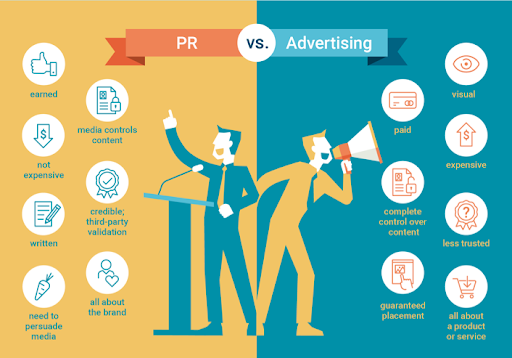
Welcome to WinnerTrick.com — the best source for success and personal development articles, motivational quotes, and tips to live your best life.
contact@winnertrick.com
Public relations is more than a series of promotional tactics—it's the strategic heartbeat of how a business communicates with the world. At its core, public relations (PR) is about shaping perception, managing relationships, and creating resonance between an organization and its many audiences: customers, investors, employees, partners, and the general public.
Rather than merely acting as a megaphone for a company’s voice, public relations strategies help organizations express their identity with purpose and clarity. Whether through press releases, keynote speeches, community events, or charity involvement, the goal remains consistent—crafting a positive public image and building long-term trust.
PR often gets lumped together with advertising, but they serve fundamentally different goals. Advertising is transactional—it aims to drive sales directly. Public relations, on the other hand, plays the long game. It's about cultivating goodwill, protecting reputation, and reducing the disconnect between how a business perceives itself and how the public sees it.

Effective PR doesn't just involve talking at people; it demands genuine listening. The foundation of great public relations is built on understanding what your audience thinks, needs, fears, and believes. It's not about spin or empty slogans—it's about honest, informed, and strategic communication.
This two-way dialogue can be a game-changer. By paying attention to stakeholders' concerns—whether they’re customers, community members, or investors—organizations can better adapt their messaging, evolve their services, and head off crises before they erupt. PR practitioners must not only be great storytellers but also skilled interpreters of public sentiment.
For small businesses, these responsibilities often fall to the owner or a small in-house team. In medium to large companies, PR duties might be outsourced to specialist agencies with broader reach and deeper industry expertise. Regardless of who handles it, the CEO or top-level management must champion the values and communication style of the brand—they are, after all, its living representation.
Public relations isn’t just about making noise—it’s about making meaningful, memorable impressions. Among the primary aims of PR are:
Strengthening brand reputation
Enhancing public visibility
Establishing credibility and trust
Maintaining consistent, transparent communication
Responding with agility during crises
At a time when consumer decisions are increasingly influenced by company values, a strong reputation can boost sales and deepen customer loyalty. PR must align with the broader marketing strategy, ensuring that branding, advertising, and public messaging support each other seamlessly.
Moreover, PR can be a bridge for community engagement. It fosters goodwill through initiatives like charity sponsorships, educational outreach, or open forums. For nonprofit organizations, this aspect becomes even more crucial—they may rely on PR to educate the public, challenge misconceptions, or advocate for policy change. Similarly, trade associations might use PR to highlight industry advancements or clear up public confusion around their operations.

The landscape of public relations is fast-paced, constantly evolving, and deeply competitive. Succeeding in this world takes more than charisma—it requires foresight, adaptability, and relentless commitment to excellence. Here are 15 tried-and-true tips for building a meaningful career in PR.
Curiosity fuels progress. The best PR professionals are relentless learners, constantly soaking up information—not just about PR itself, but about the world around them. Industries change, audience preferences evolve, and communication channels shift. Staying curious ensures you don’t get left behind.
Whether it’s learning a new media monitoring tool, understanding a cultural movement, or studying changes in digital platforms—there’s always something new to absorb. Keep your mind open and your skills sharp.
Being tuned in is essential. Clients, stakeholders, and media contacts will expect you to have a working knowledge of current events. Whether it's global politics, tech trends, or niche industry news, your understanding of the world can dramatically impact the relevance and timeliness of your messaging.
Choose a method that works for you—read reputable newspapers, follow curated news apps, subscribe to relevant newsletters, or set Google alerts. Make staying informed part of your daily routine, like brushing your teeth or grabbing your morning coffee.
Small mistakes can have big consequences in PR. A typo in a press release. A misquoted executive. A wrong date for an event. These aren’t minor slip-ups—they’re credibility killers.
Professionals who consistently deliver meticulous, error-free work quickly gain a reputation for reliability. That attention to detail builds trust and distinguishes you as a go-to person on any team. Re-read everything. Check your data. Verify your sources. And yes, even check your own assumptions.
PR isn't a linear job—it’s a chaotic ballet of overlapping projects, urgent requests, spontaneous calls from journalists, and ever-shifting deadlines. Whether you work for an agency managing multiple clients or are the solo PR lead at a startup, your ability to juggle is critical.
Learn how to triage tasks. Use productivity systems that help you sort the urgent from the important. Know when to focus deeply and when to pivot. Managing client expectations is just as important as managing your time. Burnout happens when priorities aren’t clear—so learn to clarify them often.

The ability to write clearly and persuasively is the lifeblood of PR. Press releases, op-eds, speeches, social posts, and crisis statements all depend on skillful writing.
The best way to improve? Write often. Read great writing. Study sentence structure. Learn editing techniques. Short, active sentences tend to land better than convoluted academic writing. If you can add “by zombies” at the end of a sentence and it still makes sense, it’s probably passive—rewrite it.
You don’t need to be a statistician, but understanding data is no longer optional in PR. Analytics are increasingly tied to campaign performance and return on investment.
Learn the basics of Google Analytics, social media metrics, email engagement stats, and how to interpret a media coverage report. Being fluent in metrics makes you more valuable and lets you speak the language of business leaders who want results, not just exposure.
Measurement isn’t an afterthought—it’s part of the whole PR lifecycle. Start by using past insights to set realistic objectives. During the campaign, keep tracking performance to make mid-course corrections. Afterward, use the results not just for reporting but also for future planning.
PR success is not just about the number of mentions—it’s about shifting perceptions, driving awareness, and ultimately contributing to larger business goals.
Every workplace has its fair share of challenges, bottlenecks, or unexpected crises. In PR, these moments can happen daily—whether it's a last-minute media inquiry, a misstep on social media, or internal miscommunication that risks going public.
Here’s where you stand out: instead of showing up with just the problem, come with a few possible solutions. Even if your suggestion isn’t perfect, your proactive mindset will set you apart. Leaders love team members who think critically, stay calm, and push things forward, even in uncertainty.
There will be days when it feels like everything is crashing down—breaking news ruins a campaign, a tweet goes viral for the wrong reasons, or your CEO gets misquoted. The PR world thrives on unpredictability.
But here’s the deal: calm is contagious. In stressful situations, your ability to keep your composure, act strategically, and focus on what can be done makes all the difference. Never underestimate the power of deep breathing, logical thinking, and a tone that inspires confidence when things go off script.
No one knows everything. Not even the senior VP of communications. Knowing when you’re out of your depth is a strength, not a weakness. Recognizing that you need advice or expertise from someone else shows maturity and self-awareness.
The key here is balance—don’t freeze. Instead, bring your best guess or outline what you’ve considered and say, “Here’s where I’m unsure—what would you recommend?” This keeps momentum alive while still leaning on the wisdom of others.
In PR, it’s crucial to know the difference between what you want to achieve, how you’ll do it, and the tools you’ll use along the way. Many newcomers blur the lines between objectives, strategies, and tactics—and that confusion leads to muddled plans and weak results.
Objectives define your goals (e.g., increase brand awareness by 20%).
Strategy outlines your plan (e.g., use influencer collaborations to boost reach).
Tactics are your actions (e.g., send products to five targeted influencers with high engagement in your niche).
When you understand this hierarchy, your campaigns become sharper, more focused, and easier to execute with measurable success.

Delivering press releases on time is part of the job—but going beyond that to become a strategic voice at the table is where real PR careers flourish. Whether you're internal or external, your goal should be to become someone leaders turn to not just for communication, but for guidance.
This means understanding the business. It means flagging risks early, highlighting untapped opportunities, and being candid when something isn’t working. Being a partner instead of just a performer changes how you're valued—and opens doors to bigger roles and responsibilities.
No one enjoys making mistakes, especially in a public-facing role. But here's the truth: failure is part of growth. The best PR professionals have horror stories—botched campaigns, awkward interviews, or misjudged pitches. What sets them apart is their ability to reflect, adapt, and move forward better than before.
The goal isn’t to avoid errors at all costs (although prevention is great), but to build resilience. Own your slip-ups, share what you’ve learned, and use those hard-earned lessons to guide future decisions.
It’s easy to fall into routines, especially if you’ve been in the same company or industry for a while. But PR professionals who grow their careers consistently look for ways to stretch themselves—whether that’s taking on a new type of client, experimenting with a new platform, or learning more about a different department’s role.
Curiosity isn’t just for rookies. Stay sharp by challenging yourself to understand new media, experiment with unfamiliar formats, or volunteer for cross-functional projects. Growth happens where discomfort begins.
Once upon a time, mastering PR meant knowing how to write a killer press release and foster journalist relationships. While those things still matter, today’s PR world is deeply integrated with converged media—a blend of earned (e.g., press mentions), owned (e.g., company blogs), and paid (e.g., sponsored posts or influencer collaborations) media.
Knowing how these pieces interact is crucial. A product announcement might start as a press release (earned), be repurposed as a blog post (owned), and amplified with sponsored ads on LinkedIn (paid). You don’t need to be a specialist in all three areas, but you must understand how they support one another and how to coordinate messaging across them.

At its essence, public relations is about human connection. Whether you’re guiding an executive through a high-stakes interview, framing a nonprofit’s message to rally community support, or helping a brand find its voice in a crowded market, PR plays a critical role in shaping how stories are told—and how they’re heard.
In a time when audiences are more skeptical, more informed, and more vocal than ever, the importance of transparent, meaningful communication can't be overstated. This makes PR not just a function of business—but a vital part of shaping culture and trust.
In PR, emotional intelligence is often more valuable than technical tools. Your ability to read a room, build rapport with stakeholders, and communicate with empathy can influence outcomes far more than the slickest media kit. Especially during crisis communication, these softer skills will determine whether you defuse or escalate a situation.
Ethics in public relations is not just about avoiding scandal—it’s about transparency, accountability, and responsible communication. With misinformation spreading faster than ever, PR pros have a duty to ensure that messages are factual, fair, and do not intentionally mislead. Long-term trust can’t be built on short-term spin.
As you're helping companies shape their brand stories, don’t neglect your own. Whether you're freelancing or climbing the corporate ladder, your professional reputation will precede you. Build a portfolio, speak at events, publish insights on LinkedIn, or contribute to industry blogs. Let people see your expertise in action.
Public relations is not for the faint-hearted. It demands agility, emotional strength, adaptability, and constant reinvention. But it also offers one of the most dynamic, creative, and impactful career paths across industries.
For those who thrive on challenge, storytelling, and connection, PR offers not just a job—but a stage to influence narratives and shape public understanding. It's a career where words carry weight, reputation is currency, and every success is built on trust.
Whether you’re just getting started or refining your career trajectory, success in public relations hinges not on gimmicks—but on grounded skill, curiosity, and a deep respect for the audiences you serve. The work isn’t always glamorous, but when done right, it’s some of the most meaningful communication work there is.
Make sure you enter all the required information, indicated by an asterisk (*). HTML code is not allowed.